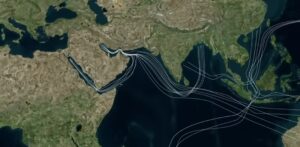
The Strait of Hormuz is a narrow waterway that connects the Persian Gulf with the Gulf of Oman and the Arabian Sea. It is a strategic chokepoint that handles the majority of the world’s oil shipments, making it one of the most important geopolitical locations globally. The significance of the Strait of Hormuz has increased over the years due to economic and geopolitical factors, leading to conflicts, power struggles, and tensions among regional and global powers.
Around 20% of the world’s oil exports pass through the Strait of Hormuz, with the daily average flow of crude oil and petroleum products being approximately 21 million barrels in 2020. This volume represents approximately 21% of global petroleum liquids consumption, making the Strait of Hormuz the world’s most important chokepoint for oil trade. Any disruption in the flow of oil through the Strait could have significant impacts on global oil prices and the global economy. Thus, the potential for disruption in the flow of oil through the Strait has led to increased tensions among regional and global powers, as well as efforts to diversify oil supplies and reduce dependence on the Strait.
Another significant geopolitical implication of the Strait of Hormuz is its role in regional power dynamics. Iran, Saudi Arabia, and the United Arab Emirates, along with the United States and China, are key players in the competition for control over the Strait. The competition has led to tensions, proxy conflicts, and power struggles among these actors.
Iran is a regional power that has a significant interest in the Strait of Hormuz. The Islamic Republic of Iran is located on the northern side of the Strait and controls a significant portion of the Persian Gulf’s coastline. Iran has threatened to close the Strait several times in the past, which has led to tensions with regional and global powers. The Iranian Revolutionary Guard Corps (IRGC) has also conducted several military exercises in the Strait to demonstrate its military capabilities and to signal its readiness to defend its interests in the region.
The United States is another key player in the geopolitics of the Strait of Hormuz. The US has maintained a significant military presence in the Persian Gulf since the 1970s, with the aim of protecting its interests and ensuring the free flow of oil through the Strait. The US Navy regularly conducts patrols in the Strait to deter any potential threats to the flow of oil. The US has also imposed economic sanctions on Iran to pressure the country to abandon its nuclear program and reduce its influence in the region.
China is also a significant player in the geopolitics of the Strait of Hormuz. China is the world’s largest oil importer and is highly dependent on oil supplies from the Persian Gulf. The Belt and Road Initiative (BRI), China’s flagship infrastructure project, includes a significant maritime component that aims to secure China’s energy supplies and expand its influence in the region. China has also been building its naval capabilities in recent years and has established a military base in Djibouti, which is located near the Strait of Hormuz.
In conclusion, the Strait of Hormuz plays a critical role in regional and global politics, with far-reaching implications for energy security, regional power dynamics, and international relations. The competition for control over the Strait has led to tensions, proxy conflicts, and power struggles among regional and global powers. Therefore, it is essential to maintain a stable and peaceful environment in the region to ensure the free flow of oil and prevent any disruptions that could lead to significant impacts on the global economy.
